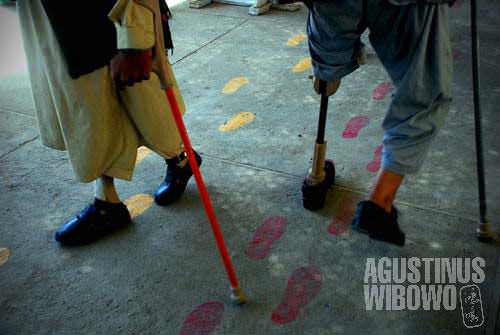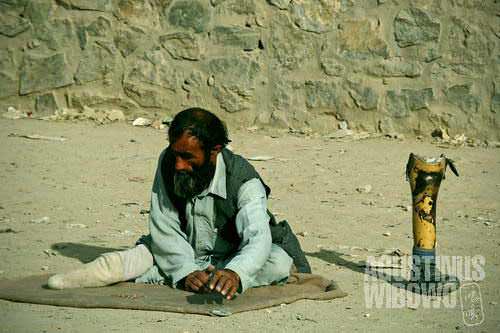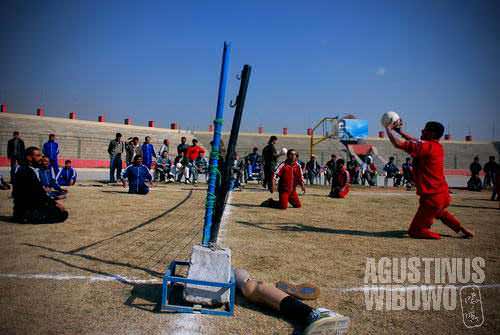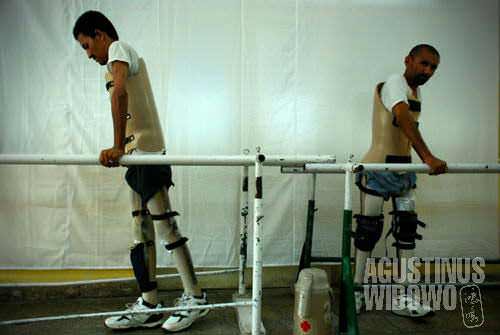Kabul – Thousands Pairs of Legs

Practising with new legs
Afghanistan, a war-torn nation, is where the handicapped war victims dominate the scene. A bazaar with armless beggars lying on hot asphalt, or pedestrian path with men sitting next to plastic legs waiting for alms, or handicapped street children crawling for tomorrow, are common things here. Fate is just decided by a simple foot step. You step on the wrong stone, and you explode. Landmines, millions of which scatter the country, are hidden enemies to bring unwanted nightmares to people. But you also may mention dozens other evil things that come along with the war: rocket, bomb blast, gun fire, malnutrition, until polio virus – which bring more and more Afghans to physical disability.
It was fate which brought Najmuddin Hemal, 43 years old, to his current position. In 1988, when he was just 24 years young, he drove his car through a river bed. What a fate. He went out to the sand, stepped on the wrong stone, and blasted. He had his two legs amputated. But the disaster didn’t end his life.
At the other end, the unwanted fate brought him a bigger opportunity to dedicate to humanity in Afghanistan. The man, who is now the Coordinator Assistant of ICRC (International Committee of the Red Cross) Orthopedic Center, has been involved in dedication of empowerment of the disabled people in Afghanistan since his last 14 years.

A doctor with damaged legs is making artificial legs for the patients
Started by being a patient in an orthopedic hospital built during Najibullah regime, he learned to become physiotherapist, but then hired by ICRC in this orthopedic center when the Russians left Afghanistan. Since 1993 he has been in charge as coordinator assistant, up till today.
What makes Najmuddin’s hospital different from others is that, almost all of the staffs are physically disabled. As himself, a double amputee walking on a pair of artificial legs, the security guard welcomes you with his plastic hand, the cleaner walk on sticks, and a computer officer input the data while standing the whole day as his body is completely paralyzed. “95 % of the staffs here are injured people,” said Najmuddin, “the rest 5%, the non-injured, are old staffs and it’s impossible to discharge them. The newer centers like those in Jalalabad and Kandahar, has 100% staffs from disabled people.” This is the policy of the hospital to enroll only the disabled. Is that a kind of discrimination to non-disabled people?
“Yes. It is discrimination. But I call this ‘positive discrimination’,” said Najmuddin. There are some points to make discrimination to be positive. First, it’s difficult for disabled people to find job out there. It is not because Afghan community discriminated the disabled due to their minor but the tendency of people to take too much sympathy to the disabled and think they are not capable in doing any kinds of job. “In fact, we can do work, as long as it’s suitable to our ability, if we are given chance.”

Almost all doctors and workers here are people with disabilites
The other reason is that this hospital is to serve the disabled. The staffs, being disabled themselves, know better what the patients need, feel, and want. The doctors have experienced themselves what their patients suffering of. The walking trainers also have experienced by themselves the first days they had to start walking with plastic legs. The plastic leg makers are making the very same things that are under their very own trousers. This hospital is, from the disabled, by the disabled, and for the disabled.
The patients, instead of being hopeless of their unwanted disability, become motivated seeing the disabled staffs. Instead of thinking being useless, they may see the staffs serving them are the similarly disabled people. Being disabled doesn’t mean being exempted from life. Being disabled doesn’t mean being useless.
But the number of disabled people in Afghanistan is growing day by day, along with the horrible cost that Afghanistan has to pay due to its never-ending decades of wars. Everyday people are injured or sacrificed by the landmines while Afghanistan still preserves its top position among the world’s most mined countries.

Many people with disabilities end up begging on the streets, because lack of opportunities
Being optimistic, the growth rate of disabled people in Afghanistan is highly reduced in recent years, thanks to aggressive de-mining projects conducted throughout the country. The hospital recorded, right after the war, there were on average 25 new patients daily, contrasted to 2-3 new casualties in recent days. It is still relatively a big number, but it is indeed brighter days for the future of the nation.
How many disabled are there in Afghanistan? There is no exact calculation. People may say 1 million or 2 million, considering big numbers of disabled people visible in community. But Najmuddin prefers to give a more confident number: 45,000 disabled in whole Afghanistan. Among them, 80% is caused by landmines. While the other 20%: rocket, polio, falling from walls, accident, fire, gun shot, and malnutrition. In a word, the continuous effects of the wars are the ones to be blamed.
Landmines, the main evil, create legless and armless community in the society. The newly injured victim has to wait 2 and half months at least until his wound of amputated parts of body dried. When it is, he is ready to come to this center to claim for artificial legs or arms to support his movement. Of course, his movement will not be free as before with this plastic body, but it does help. At first, one has to practice to familiarize himself with his new plastic body which is made especially for his very own measure. It can take anywhere from 5 to 20 days to be able to walk with the new legs properly. The time does not vary on whether he lost his left or right leg, but whether the injury is beyond or below the knee. If the amputation happens at the lower leg, it means he has to replace the ankle with plastic leg to walk. When it is beyond knee, he has to control two joints: knee and ankle, to be able to walk, thus requires more time. For the first case, one needs five days to a week, while for the second case up to 10 days. The time multiplied if he lost both of his legs. Children usually learn it faster than adult, and men faster than women.

They are not disabled, they have special abilities
It is a hall known as ‘fix ground’ where the people practice with their new legs. So called because the legs should be fixed to suit every patient’s unique autonomy. There is a curtain to separate the women from the men. There are two lines of foot path marked on the floor, so the new leg owners now can walk along the path to harmonize their new steps. Handrail is also available to ease the newcomers. Step by step. I heard click and clack of unfinished plastic legs combined with click and clack of wooden sticks. Doctors in charge, most of them are plastic leg users themselves, help the patients and ask kindly whether they have problems with the new feet. They, then measure again and re-fix the leg, to give the most suitable one to everybody.
War victims dominate the hall. All ethnics are here. Pashtuns, Tajik, Hazaras. Different languages are spoken. Wars don’t harm certain ethnics but hurt all. The 23 year old Abdul Qadir came along with his ICRC card to practice his artificial leg. Three days after the death of Ahmad Shah Massoud – Afghan national hero, and to avoid Taliban which is coming to the capital, he tried to escape to Panjshir. But unfortunate for him, Taliban shot him and it caused the left leg to be amputated. The jobless, helpless, uneducated Qadir came to this ICRC hospital. The all-for-free service from the hospital provided him with a new leg. Talking about his past, about his regret of being uneducated, he only has one to blame: war.
Nur Muhammad, 33 years old Hazara man from Wardak, came all the way from Turkey to get this new leg. The confident jeans factory owner lost his left leg due to a fighting 14 years ago. After practicing the plastic leg, with joints on ankle and knee, he feels he can control it 40% in 4 days training. “I can walk better now,” he smiles proudly.
It is the matter of confidence, says Najmuddin, which the plastic legs change the view of the disabled to their future. It does indeed help the movement of injured people, but it is more important that the plastic body parts help to reduce frustration of being disabled.

New legs and new bodies, new spirit, new life
There are some young children also practicing to walk here. The poor five-year-old Parveez suffered from his hunchback and the 14-year-old Kabuli Pashtun boy, Zainullah, has to have two plastic legs to replace his paralyzed ones due to polio. About his sickness, Zainullah says, “When I was younger I was playing with dirty water. Then I got sickness and cannot walk properly.” The fourth grade students used to walk painfully to his school, 2 km away from his house. It was pain, but now the pain is much reduced by his new plastic legs.
New steps are being made. New hopes are being created. The legless people now can walk through the path the others do. The thousand pairs of plastic legs are there, to bring brighter future for the nation devastated by cruel wars.



Leave a comment